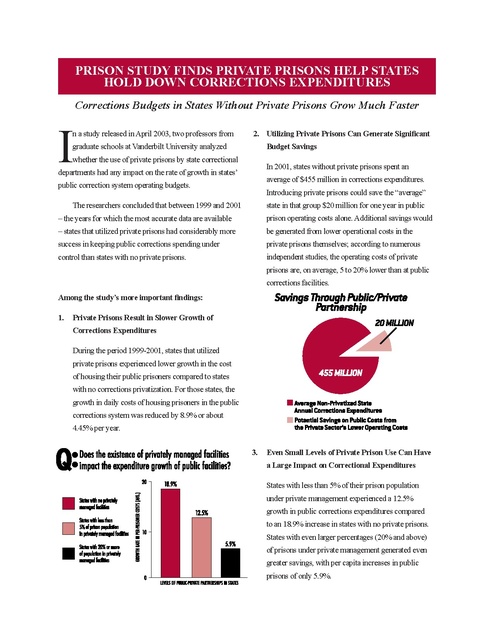Cca Prison Study Finds Private Prisons Help States Hold Down Corrections Expenditures Vanderbuilt Study Summary
Download original document:

Document text

Document text
This text is machine-read, and may contain errors. Check the original document to verify accuracy.
PRISON STUDY FINDS PRIVATE PRISONS HELP STATES HOLD DOWN CORRECTIONS EXPENDITURES Corrections Budgets in States Without Private Prisons Grow Much Faster I n a study released in April 2003, two professors from 2. Utilizing Private Prisons Can Generate Significant Budget Savings graduate schools at Vanderbilt University analyzed whether the use of private prisons by state correctional In 2001, states without private prisons spent an departments had any impact on the rate of growth in states’ average of $455 million in corrections expenditures. public correction system operating budgets. Introducing private prisons could save the “average” state in that group $20 million for one year in public The researchers concluded that between 1999 and 2001 – the years for which the most accurate data are available prison operating costs alone. Additional savings would – states that utilized private prisons had considerably more be generated from lower operational costs in the success in keeping public corrections spending under private prisons themselves; according to numerous control than states with no private prisons. independent studies, the operating costs of private prisons are, on average, 5 to 20% lower than at public corrections facilities. Among the study’s more important findings: 1. Private Prisons Result in Slower Growth of Corrections Expenditures During the period 1999-2001, states that utilized private prisons experienced lower growth in the cost of housing their public prisoners compared to states with no corrections privatization. For those states, the growth in daily costs of housing prisoners in the public corrections system was reduced by 8.9% or about 4.45% per year. 3. Even Small Levels of Private Prison Use Can Have a Large Impact on Correctional Expenditures States with less than 5% of their prison population under private management experienced a 12.5% growth in public corrections expenditures compared to an 18.9% increase in states with no private prisons. States with even larger percentages (20% and above) of prisons under private management generated even greater savings, with per capita increases in public prisons of only 5.9%. The following table compares the growth of cost per prison in states that permit privately operated prisons versus those that do not. Growth in Per Diem Cost for Public Prisoners by Percent of Prisoners in Private Facilities Percent Private Prisoners I. Yes/No Private Prisoners* No Yes p-value II. By Percentage None < 5% 5% to < 10% 10% to < 20% 20% or higher Total 1999 to 2001 Average Growth in Cost per Public Prisoner Number of States 18.9% 10.8% 0.09 19 30 18.9% 12.5% 12.1% 9.7% 5.9% 14.0% 19 9 10 7 4 49 Note: Due to lack of data on Department of Corrections expenditures, Alaska was eliminated in the 1999-2001 comparison. Since Alaska authorized privately held prisoners in 1999, a total of 30 states had privately held prisoners in 1999, while 20 did not. A number of variables were assessed in the statistical diem expenditures (net of private prisons); percentage of study, including: the number and percentage of prisons under court order; differences in the cost of living prisoners in private facilities; overall state government across states; percentage of prisoners held in maximum expenditures per capita; Department of Corrections per security facilities; and prison capacity utilization. About the Researchers James F. Blumstein is a Centennial Professor of Law, Vanderbilt Law School; Director, Health Policy Center, Vanderbilt Institute for Public Policy Studies. B.A. (Economics), Yale College; M.A. (Economics), Yale University; LLB, Yale Law School. Institutional affiliations for identification only. Mark A. Cohen is a Professor of Management (Economics), Owen Graduate School of Management, Vanderbilt University; Director, Vanderbilt Center for Environmental Management Studies; Leverhulme Visiting Professor and Visiting Professor of Criminal Justice Economics, University of York (U.K.). B.S.F.S., Georgetown University; M.A. & Ph.D., Carnegie-Mellon University. Institutional affiliations for identification only. A complete copy of the study is available by contacting the Association of Private Correctional & Treatment Organizations – Andy LeFevre, executive director, (703) 548-8532, www.apcto.org, or Corrections Corporation of America – Louise Green, vice president marketing, (615) 263-3106, www.correctionscorp.com (press release section). These two organizations funded the study.

